Contents
- 1. Ritualistic worship
- 2. Arrangement of deities in the temple room according to spiritual science
- 3. Articles used in ritualistic worship
- 4. Usage of kalash in ritualistic worship
Namaskar! We heartily welcome you all for this Satsang (spiritual meet)! Before we commence this Satsang let us pay obeisance at the Holy feet of Sadguru (spiritual master) so that by His grace the very objective of this Satsang is fulfilled. Please pay mental obeisance to your personal icon of faith and recite as follows:
गुरुर्ब्रह्मा गुरुर्विष्णु गुरुर्देवो महेश्वर: ।
गुरु साक्षात् परब्रह्म तस्मै श्री गुरवे नम: ।।
1. Ritualistic worship
Every religious ritual of Hindu Dharma consists of various components. Every component has its own significance and these components have their own special design that is the shape, height and breadth of every component is fixed or unique. The reason underlying such a design is that the every component should be able to absorb the chaitanya (divine consciousness) present in the atmosphere. Besides the objective of spiritual science or scriptures is to make that component conducive and complimentary for the man to receive the divine consciousness.
When we see around with this point of view we find that people do perform puja and mental worship (upasana); they do have spacious temple rooms in their home but since their actions or rituals are not according to spiritual science due to ignorance, they do not get the desired benefit. Therefore in the case of worship, action at every level starting from temple room has to be according to spiritual science. It is essential that our temple room be sattvik. As far as possible it should be made up of teakwood and its colour should be wooden. The orientation of temple room should be in east-west direction. There should be no Kalas (a small dome shaped structure with a pointed end) above it. We have to take into consideration all these factors.
2. Arrangement of deities in the temple room according to spiritual science
Every Hindu has his seat of faith. We do have idols and images of the deities in our temple room so that we remember our icon of faith constantly and thus firmly establish our seat of faith. However we do not get the expected benefit. That is because we do not know as to what is essential for us.
While observing this we have to take into consideration one more point and that is we should not do the arrangement of idols or images in a temple room according to our whims and fancies. We have to be aware of the fact that the arrangement should be correct from the point of spiritual science.
In some sects the deities are arranged in temple room in what is called Panchayatan form.The word Panchayatan consists of Panch which means five and Ayatan which means house. The five main deities considered here are Shri Vishnu, Shiva, Shri Ganesh, Devi and Sun deity. In this type of arrangement one of the five deities is considered as Chief deity and is offered a central seat and rest of the four deities are placed in four directions around it.
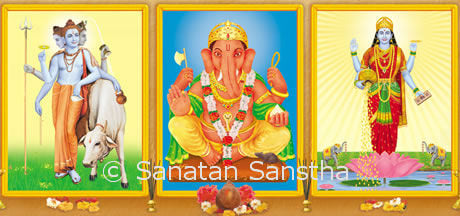 |
Now let us see what is essential for us from a spiritual perspective:
Many a times it so happens that we have many images of deities in our temple room but the images of family deity (Kuldevata) and Ganesh are missing. If that is so then we have to set up images of family deity and Ganesh with utmost devotion. If according to the family traditions we are also involved in the worship of such deities as BalKrushna, Hanuman and Annapurna or such superior deities as Shri Shiva or Durgadevi, then we should keep their images too.
The language of human beings is in words which is a language of ‘sounds’ while the language of deities is of ‘light’. Shri Ganapati does the function of converting our language of sound into the deities’ language of light and vice versa; therefore it is essential to set up an image of Shri Ganapati in the temple room.
We all know that in the beginning of all functions religious or otherwise Shri Ganapati is invoked first and worshipped because he is destroyer of vighnas or obstacles. The other reason being through Him our prayers to the deities reach them faster.
2.1 Why should Shri Ganapati be kept in the centre?
Now let us see how the arrangement of deities in the temple room be. According to spiritual science the arrangement should be in the form of cone.
We have to keep the image or picture of Shri Ganapati in the centre. Then towards our right hand side the images of female deities such as Family Deity is kept. Then images of other deities like Annapurna, Durgamata are kept one behind the other. On our left we have to keep images of male deity that is male family deity. Then such images of deities like Hanuman, Balkrushna etc. are arranged one behind the other.
Sometimes we may find that in an image male deity and female deity are together. For example Seeta-Ram, Lakshmi-Narayan etc. In a picture where the female deity is on the left side of male deity then it is assumed that she is giving blessings to her devotees along with her Shri. This is her savior form. In such a picture the male deity is considered the main deity and such a picture is kept to the right hand side of Shri Ganapati. In some pictures the female deity is shown on the right side of the male deity. This is her destroyer form. In such a picture the female deity is considered to be the main deity and is kept to the left of Shri Ganapati.
There are mainly two forms of a deity: Saviour and destroyer. The form which blesses the devotee is called Saviour or Tarak form . Such a deity is generally shown to be in blessing mudra (certain hand gestures) for example Devi Mahalakshmi.
The form of Devi who kills the demon for example Mahishsur Mardini, who killed the demon Mahishasur is an example of destroyer form of Devi. We have to keep the picture of that form of deity in the temple room in which we are going to worship Her or Him.
After knowing the science underlying the arrangement of deities in the temple room our viewers must have had some doubts in their minds. So let us see what are the answers to such doubts.
A. One of the doubts may be that whether it is correct to have number of deities in the temple room?
It is prudent to have a limited number of deities in the temple room. Here we have to remember that according to science of spirituality we need to come from many to one. One who is a disciple that is who has already acquired a spiritual guide or Guru and is staying alone then he should keep only Guru’s photo or picture in the temple room.
According to the holy verse ‘Gurur Bramha Gurur Vishnu Gurur Devo Maheshwaraha | Guru Sakashat Parabramha tasmai Sri Gurave namaha |’ guru is everything and the only thing for a disciple. That is why he should keep only Guru’s photo or picture in the temple room.
B. If other family members have faith in any other deity then what is to be done?
If Guru is a man then His picture or photo has to be kept on the immediate right side of Shri Ganapati and then the image of male family deity is to be kept besides it followed by other male deities as mentioned previously. When the Guru is female then Her picture or photo has to be kept on the immediate left side of Shri Ganapati and then the female family deity to her left followed by the pictures of other female deities as mentioned before.
So up till now we have understood about the arrangement of deities in a temple room according to spiritual science. We hope that you will be definitely doing the arrangement of deities in your temple room according to the spiritual science as described in this satsang so that you will be benefitted spiritually. By following such arrangement you will have spiritual experiences which are beyond mind and intellect.
3. Articles used in ritualistic worship
As we move next the important action is ritualistic worship of deities. In this age of strife called kaliyug the worship of the path of devotion is recommended. Each person following the path of devotion has an important part of worship and that is ritualistic worship of deities or puja. If ritualistic worship is done with spiritual emotion then we get more benefit of deity principles. In order to get the grace of the deities with the help of puja, the articles like platter of puja, lamp, bell and conch are the important useful components.
Let us now see about the articles used in ritualistic worship of deities. They are the tools used for the ritualistic worship of our adorable deity. There are subtle frequencies of deities present in the atmosphere. The articles or tools of puja or rituialistic worship are an excellent medium of receiving and transferring them to the worshipper. That is the importance of these tools from the spiritual science point of view.
We are quite familiar with various tools used in puja ritual such as kalash ( a copper pot), copper plate, spoon (achamani), a cylindrical copper vessel (panchapatra), abhishekpatra (a vessel meant for giving holy bath to the idol of deity), tilak ( sandalwood paste), naivedya (food offering), Cups meant for putting Panchamrut (five substances like sugar, milk, honey, curds and clarified butter), a platter, the stand for inserting incense sticks, Pancharati (a type of lamp with five edges meant for waving), bell and basket meant for keeping flowers. The metal articles are mostly made up of gold, silver, bronze, copper or brass.
3.1 Importance of copper as compared to other metals in ritualistic worship
Now a days use of stainless steel is prevalent. But it has less capacity to absorb sattvik frequencies as compared to the metals mentioned before. Therefore the worshipper derives minimal benefit.
Thus we have seen that the metal articles are mostly made up of gold, silver, bronze, copper or brass. But amongst them copper is most important. Let us see its specialties.
According to science of spirituality the articles prepared from copper have an important place in deity worship. This is because copper has 30% capacity to imbibe sattvikta (the quality of sattva) when compared to other metals. Besides it has also 70% ability to destroy the raja–tama. Just as copper has the ability to absorb the sattvik frequencies of deities, it has also capacity of transmitting them. Thus it becomes rich in divinity in a short period. The sattvik frequencies of deities are then transferred to other components of puja. Therefore copper is considered an auspicious metal.
It has been seen that some people use metal articles descended down the family lineage. Here the question may arise as to how appropriate is this from the view point of spiritual science?
The effect of spiritual emotion of a worshipper towards the God is exactly reflected in the puja tools. Currently most of the people are lacking in such spiritual emotion. Therefore the new tools used by them do not have the ability to absorb the sattvikta. When such articles become old after many years of use in puja and aarti only then they develop such capacity to absorb sattvikta. Therefore the use of new articles is not that beneficial.
Up till now we came to know about the articles in brief. Now let us see some of them in details.
4. Usage of kalash in ritualistic worship
Kalash ( water vessel) is an auspicious symbol of Hindu culture. It was generated during the Samudramanthan or great churning of ocean. Shri Vishnu held Kalash filled with nectar during Samudramanthan. All deities reside in the kalash. Therefore it has an important place in puja ritual. Let us understand this with the help of a subtle drawing.
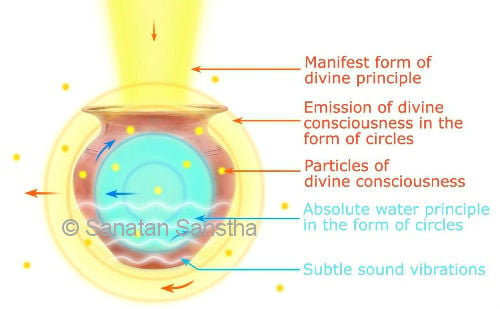 |
There is a certain space in the kalash which generates subtle sound vibrations which are of white colour. The manifest principle of a deity having yellow colour is seen getting attracted to the kalash. The blue circles seen inside the kalash is indicative of aap element (absolute water element). The circles and particles of chaitanya (divine consciousness) are seen projecting from the medium of kalash.
Now let us see why is water used in a kalash and why is it that the leaves of mango tree or that of betel vine are kept in it?
4.1 Why are mango leaves or betel vine leaves kept in the kalash ?
The kalash is used for creating seat for invoked deities during the puja ritual. First it is filled with water and then leaves of mango tree or that of betel vine are kept in it. These leaves are known as leaves of deity’s seat. The deity principle gets maximally attracted to these leaves of seat. The water inside the kalash keeps this seat pure till the ritual of Pranapratishta (invoking deity into an image, idol, coconut or betelnut). Thus the invoked deity principle stays for a long period.
In this kalash betel nut or some coins are then put. Thereafter a coconut is set up on the mouth of the kalash. The tuft of coconut attracts the deity principle from the atmosphere and it is then transmitted to the water in the kalash through the body of cococnut.
The water is pure and clean to the highest extent. That is the reason it is able to attract the sattvik particles of frequencies of deities. But it contains less quantity of raja particles and therefore has poor capacity to project the sattva particles.
Putting a coin is symbol of sacrifice. Through this medium there is sacrifice of wealth and jiva (embodied soul)’s attachment is reduced. This qualifies the worshipper to benefit more from the sattvikta of puja ritual. A copper coin is put in the kalash. The copper has more capacity to project sattvik frequencies. It helps in emanation of sattvik frequencies present in the water into the atmosphere.
Also a betel nut is kept in the kalash meant for puja ritual. Betelnut enhances sattva and raja components in the water of the kalash. This increases the capacity of the water to emit manifest principle of deity.The betel nut contains particles related to absolute earth element which are useful in binding of sattva particles related to sattva component.This then easily helps in retaining the sattvikta of water for along time. Five precious stones like pearl, diamond, emerald, blue sapphire, ruby and gold are also added to the water of kalash. The five precious stones and gold have capacity to attract and emit the principles of five superior deities. This benefits the worshipper. But with changing times the use of five preious stones and copper is reduced and replaced by alloys which are spiritually of less benefit.
Now let us see as to why the water stored in the kalash is either poured under the Tulsi plant or is sprinkled in the premises after the conclusion of puja.
4.2 Why is the water stored in the kalash either poured under the Tulsi plant or sprinkled in the premises?
We are all familiar with the immense importance of Tulsi in Ayurved and spirituality. The purity means predominance of sattva attribute. Tulsi has more capacity to attract pure vibrations from the atmosphere than any other plant. It also emits sattvik vibrations in the atmosphere all the twenty four hours. The Tulsi absorbs the deity principle when chaitanya enriched water when poured under it and then emits them along with its sattvik vibrations. This creates the envelope of vibrations of deity and the atmosphere around the premises remains pure. This is form of divine armour. Similarly when water from the kalash is sprinkled in the premises, the vibrations of deity principle are emitted in high proportion in the premises and helps in its purification.
Thus up till now we have learnt about the kalash and the substances kept in it during a puja ritual.
|
For more information on this article read Sanatan’s publication ‘Temple at home and Implements used in the worship of God (Scientific Importance and Arrangement)’. |
Close-up: If you get any spiritual experiences by following the view points mentioned in today’s Satsang or if you have any queries about the topic presented today, please inform us. Our contact details are [email protected]

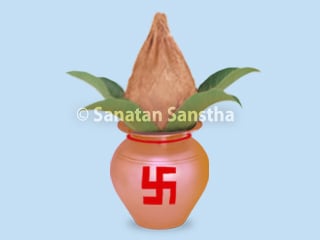
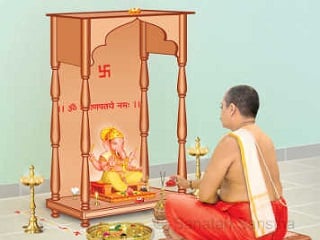 How to perform Puja Vidhi ?
How to perform Puja Vidhi ? Importance of Puja Samagri in ritualistic worship
Importance of Puja Samagri in ritualistic worship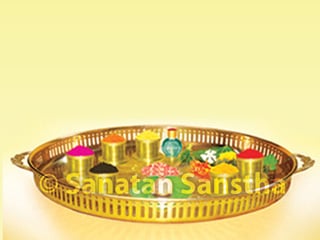 How to arrange the substances in Puja Thali ?
How to arrange the substances in Puja Thali ?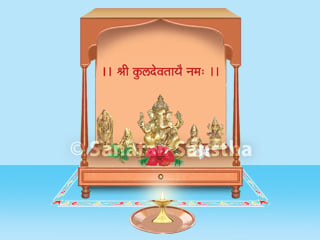 How should be the design of Devghar ?
How should be the design of Devghar ?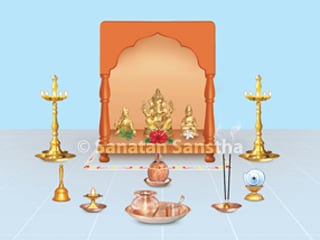 How to arrange the Puja items used in puja ?
How to arrange the Puja items used in puja ?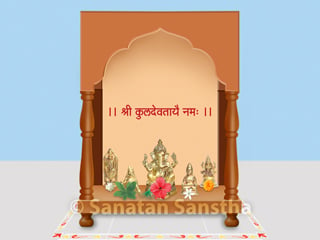 How to arrange Deities in Home temple ?
How to arrange Deities in Home temple ?
nice article… and great infromation….thanks for sharing…